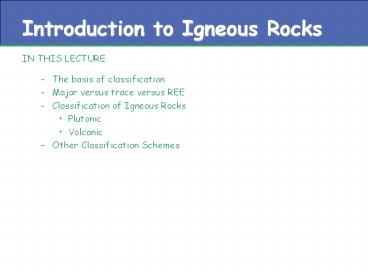Introduction to Igneous Rocks - PowerPoint PPT Presentation
Title:
Introduction to Igneous Rocks
Description:
Plutonic Rock an igneous rock with a phaneritic texture, i.e. a ... Rocks that contain more than 50 % modal carbonate and have a plutonic or volcanic origin ... – PowerPoint PPT presentation
Number of Views:509
Avg rating:3.0/5.0
Title: Introduction to Igneous Rocks
1
Introduction to Igneous Rocks
- IN THIS LECTURE
- The basis of classification
- Major versus trace versus REE
- Classification of Igneous Rocks
- Plutonic
- Volcanic
- Other Classification Schemes
2
Classification of Igneous Rocks
- Why is it necessary to have a system for the
classification of igneous rocks? - Lots of different names used lots of difference
people - A classification scheme is therefore useful so
that everyone knows if they are talking about the
same rock.
3
The Basis of Classification
4
Major versus Trace versus REE
- Mineral compositions normally only specify the wt
oxide of the major elements, these being, Si,
Ti, Al, Fe, Mg, Ca, Na, K, P and sometimes Cr,
Ni, and S. - For a whole rock composition, major elements
(same of minerals) as well as trace elements and
REEs are often reported and can be used in the
classification of igneous rocks and
discrimination diagrams.
5
(No Transcript)
6
Classification of Igneous Rocks
- The primary classification of igneous rocks
should be based on their mineral content or mode
using the QAPF diagram - Q modal volume proportion of quartz, tridymite,
cristobalite - A modal volume proportion of alkali feldspar,
including orthoclase, microcline, perthite,
anorthoclase, sanidine, and albitic plagioclase
(An0 to An5) - P Plagioclase (An5 to An100) and scapolite
- F feldspathoids or foids including nepheline,
leucite, kalsilite, analcime, sodalite, nosean,
haüyne, cancrinite, and pseudoleucite. - This diagram should not be used in rocks that
have M gt 90 where M mafic and related minerals
e.g. mica, amphibole, pyroxene, olivine, opaque
minerals, accessory minerals (e.g. zircon,
apatite, titanite, monazite), epidote, allanite,
garnet, melilite, monticellite, and primary
carbonate.
7
Classification of Igneous Rocks
- Plutonic Rock an igneous rock with a phaneritic
texture, i.e. a relatively coarse-grained (gt3mm)
rock in which individual minerals can be
distinguished with the naked eye. - Volcanic Rock an igneous rock with an aphanitic
texture, i.e. a relatively fine-grained (lt1mm)
rock in which most of the individual minerals
cannot be distinguished with the naked eye. - Therefore QAPF diagrams are useful for
classifying plutonic rocks but not so much for
volcanic rocks
8
Plutonic rocks Mlt90
9
Volcanic Rocks Mlt90
10
IUGS Classification of Gabbroic Rocks
11
IUGS Classification of Ultramafic Rocks
12
Geochemical Classification Volcanic Rocks
Chemical Clasification of Volcanic Rocks using
TAS (total Alkali-Silica Diagram) after le Bas et
al., 1986
13
Other Classification Groups
- Other classification groups are
- Pyroclastic rocks and tephra
- Formed by fragmentation as a result of explosive
volcanic eruptions or processes - Carbonatites
- Rocks that contain more than 50 modal carbonate
and have a plutonic or volcanic origin - Melilite-bearing rocks
- Rocks that contain more than 10 modal melilite
and if feldspathoids are present melilite gt
feldspathoid - Kimberlites
- Group I and Group II
- Lamproites
- Based on mineralogical and geochemical criteria
14
Other Classification Groups
- Other classification groups are
- Leucite-bearing rocks
- Rocks containing little or no feldspar
- Lamprophyres
- Several characteristic criteria
- Charnockitic rocks
- Characterised by the presence of orthopyroxene
(or fayalite quartz) and in many rocks
perthite, mesoperthite or antiperthite.

